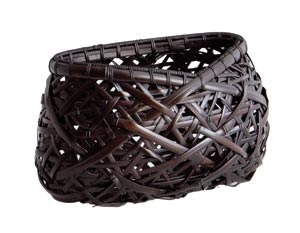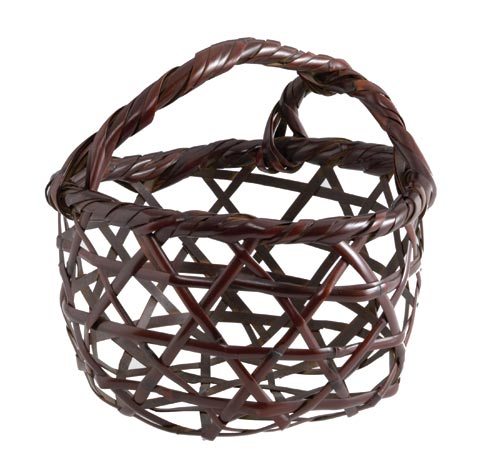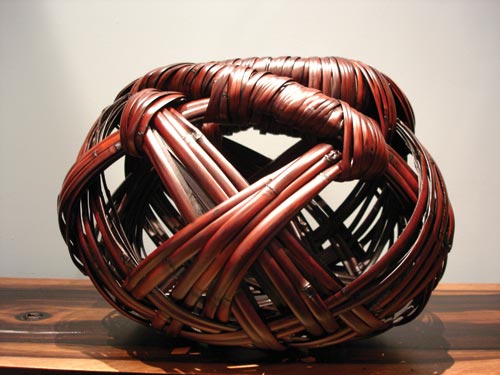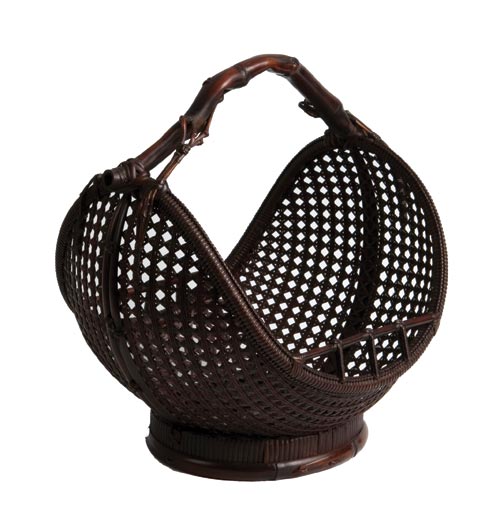
As indicated in the opening of this poem by a contemporary basket maker, bamboo – rapidly growing and quickly spreading – occupies an important position in Japanese artistic tradition. On the one hand, the delicate fronds of the natural plant appear as a recurring motif on scrolls, ceramics, and metalware. On the other, mature bamboo stalks can be used in various forms to make furniture, carts, and baskets.
A 1999 exhibition catalog quoted basket artist Minoura Chikuho (b. 1934) on the subject of the material: “Bamboo has a certain tenderness, a breathing quality. When you weave it and pattern it, light passes through it; it is transparent and solid at the same time.’
“It also retains the qualities it has in nature, flexibility and strength, with the ability to spring back into shape whenever you bend it. In winter the bamboo bends right down under the snow. When spring comes again and the snow melts, the bamboo leaps back up as if nothing has happened.”
Japan emerged from a period of political isolation in the second half of the 19th century and began exhibiting traditional arts and crafts at well-attended world’s fairs beginning with London in 1862. The Meiji government (1868-1912) encouraged industry and foreign trade. The result was a greater international appreciation of the culture and a new passion for Japanese style. Witness the success of Gilbert and Sullivan’s operetta, The Mikado, in 1885.
While connoisseurs focused on what were considered fine arts such as painting and calligraphy, it was hard not to notice the artistry used in making everyday objects like pottery and baskets. Through the world’s fairs, Westerners were also introduced to ikebana, or the Japanese art of flower arranging, which often made use of such containers to hold the stems.
Although utilitarian basket-making in Japan goes back to ancient times, collectors of historic bamboo baskets focus on beautifully executed examples made to hold flowers, which played an important role in the ritual of the tea ceremony. Most of these examples, which now have developed rich patinas from loving hands and smoky interiors, date to the late-19th and early 20th centuries. Most are well preserved, thanks to the fitted tomobako boxes in which they were stored.
In a 2007 show at their gallery in New York City, Erik and Cornelia Thomsen gathered more than 20 examples for Masterworks in Bamboo: The Japanese Ikebana Basket. “These baskets were highly prized by tea masters and commanded princely sums in the peak years of basket making during the Taisho and early Showa periods, circa 1910-1940,” Erik Thomsen said. “Their beauty is obvious in their form and, upon closer inspection, in the skillful workmanship of the fine details.”
The exhibition included many signed examples, showing the pride the masters took in their work. The baskets on display, priced from $2,000 to $40,000, included everything from a smoked bamboo masterwork by Iizuka Rokansai (1890-1958) to a 1970 work by Tanabe Chikuunsai II (1910-2000), an artist from an important Osaka basket-making family.
After the show closed, Thomsen said, “We sold many baskets; most are in a manageable price range. My clients are almost always Westerners, Europeans and Americans. These old baskets are getting very difficult to find – the signed examples, the exceptional ones. Not many were made.”
The eye-opener for Western collectors was a 1999 Asia Society exhibition in New York City of 100 examples titled Bamboo Masterworks: Japanese Baskets from the Lloyd Cotsen Collection. Cotsen, a former CEO of Neutrogena, said at the time, “I was attracted by the tensions created by the balancing of forms: of cohesion and chaos, structure and nature, refinement and exuberance, and, ultimately, simplicity and complexity.”
Mary Hunt Kahlenberg was one of the curators of the New York exhibition and husband Robert Coffland was a “basket hunter” for Cotsen. While in Japan, looking for what are called “historic” or pre-World War II baskets, Coffland discovered a renaissance of bamboo art throughout the country. The couple founded Tai Gallery in Santa Fe, N.M., which exhibits the work of modern Japanese bamboo artists. They also present this material at major antique fairs and exhibit at the TAMA Gallery in New York City.
Coffland has two books in print, Hin: The Quiet Beauty of Japanese Bamboo Art with Donald Doe, and Contemporary Japanese Bamboo Arts, from which the abovementioned artist quotes were drawn. Both volumes contain useful essays on the history of bamboo art and further bibliography. The baskets illustrated make it clear that contemporary bamboo artists have moved beyond merely crafting containers to creating unique sculptures out of natural materials.
“They’re more meant to be an object in and of themselves. If you look on our website, there are pieces that are purely non-functional,” Coffland said. But, he added, “I love historic baskets. You can’t have the present without the past. There’s a wonderful continuity of the tradition. Whether something is old or new is irrelevant to whether it touches the heart, ” he said.
“The range of creativity is just astonishing. I’m in Japan three or four times a year, and I see something new every time, whether it’s a historic basket or something contemporary artists are doing. It’s very much a living, ongoing tradition that is ironically almost totally overlooked by the Japanese.” Many of the collectors buying the work of artists represented by the Tai Gallery are savvy Westerners who realize their lasting artistic value. Prices fall in the $10,000 to $30,000 range. But for that amount, he said, “you can get something stunning that will stop people in their tracks when they come into your home. That’s part of the fun of this for collectors.”
The artistry of these pieces has attracted the attention of major American museums. In 2001, the Philadelphia Museum of Art acquired for its permanent collection a sculptural bamboo basket titled Let It Be by Tanabe Takeo (b. 1973), a fourth-generation member of a famous basket-making family in Osaka.
Felice Fischer, the Luther W. Brady Curator of Japanese Art, said of the artist: “His great-grandfather, Chiku’unsai I, began making bamboo artifacts in 1890, and had the first one-man exhibition of bamboo crafts in 1915. Trained by his grandfather and father in the craft, Tanabe also studied sculpture at the National University of Fine Arts and Music in Tokyo. The hallmark of Tanabe’s work is the beautiful amalgam of traditional technique and craftsmanship with a contemporary sculptural sensibility.”
One warning for collectors: While modern artist-created baskets may bear art-market prices, collectors should be wary of inexpensive but poorly made imitations, often found in gift shops. Just as early basket-makers once copied Chinese shapes for their tea ceremony flower holders, floods of cheap bamboo baskets approximating Japanese models are now being shipped from China and Southeast Asia. A quick look at the workmanship should be sufficient. As always, reputable dealers will answer questions, facilitate examination of examples, and recommend further reading.
ADDITIONAL IMAGES OF NOTE






